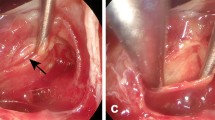Abstract
Objective
In this study, we investigated the surgical technique and endocrine assessment of pituitary function of patients with macroadenoma treated by extra-pseudocapsular transnasal transsphenoidal surgery (ETTS).
Methods
Clinical data of 144 patients with pituitary macroadenomas in the same surgical group at the Department of Neurosurgery, Tongji Hospital, Tongji Medical College, Huazhong University of Science and Technology were retrospectively analyzed from January 2019 to June 2021. Based on the results of the endocrinological evaluation and MRI examinations before and after surgery, the fluctuation of pituitary function and the extent of resection were analyzed. Multiple Logistic regression analysis was used to determine the predictors affecting postoperative tumor residual.
Results
Among the 144 patients with pituitary macroadenomas, 72 (50.0%) were female and 72 (50.0%) were male, the median age was 50 years, 26 (18.1%) had invasiveness grade 0, 46 (31.9%) had grade I, 57 (39.6%) had grade II, and 15 (10.4%) had grade III according to Lu’s classification method. Based on observation during surgery, 37 cases (25.7%) had no pseudocapsule, 54 cases (37.5%) had incomplete pseudocapsule, and 53 cases (36.8%) had intact pseudocapsule. In addition, 91 (63.2%) patients had total resection, 39 (27.1%) had subtotal resection, and 14 (9.7%) had partial resection. As for anterior pituitary function, 13 of 19 hypothyroid patients had recovery after surgery, with a remission rate of 68.4%. Eighteen of the 26 decreased cortisol patients got back to normal, with a remission rate of 69.2%. A total of 27 of 51 patients with hypogonadism improved, with a remission rate of 52.9%. Univariate and multivariate analyses indicated that gender, tumor size, and invasiveness were predictors of postoperative residual in patients (P<0.05).
Conclusion
The results showed that ETTS is an effective treatment modality for restoring the function of pituitary gland of the patients with macroadenomas. Tumor size and invasiveness are predictors of the extent of surgical resection and postoperative residual of macroadenomas.
Similar content being viewed by others
References
Wurth R, Thellung S, Corsaro A, et al. Experimental Evidence and Clinical Implications of Pituitary Adenoma Stem Cells. Front Endocrinol (Lausanne), 2020,11:54
Molitch ME. Diagnosis and Treatment of Pituitary Adenomas: A Review. JAMA, 2017,317(5):516–524
Lu L, Wan X, Xu Y, et al. Prognostic Factors for Recurrence in Pituitary Adenomas: Recent Progress and Future Directions. Diagnostics (Basel), 2022,12(4):977
Nimsky C, von Keller B, Ganslandt O, et al. Intraoperative high-field magnetic resonance imaging in transsphenoidal surgery of hormonally inactive pituitary macroadenomas. Neurosurgery, 2006,59(1):105–114
Buchfelder M, Schlaffer SM. Intraoperative magnetic resonance imaging during surgery for pituitary adenomas: pros and cons. Endocrine, 2012,42(3):483–495
Buchfelder M, Schlaffer SM. Intraoperative Magnetic Resonance Imaging for Pituitary Adenomas. Front Horm Res, 2016,45:121–132
Buchfelder M. Comment on Microsurgical therapy of pituitary adenomas. Endocrine, 2018,61(1):42
Taylor DG, Jane JA, Oldfield EH. Resection of pituitary macroadenomas via the pseudocapsule along the posterior tumor margin: a cohort study and technical note. J Neurosurg, 2018,128(2):422–428
Lu L, Wan X, Xu Y, et al. Classifying Pituitary Adenoma Invasiveness Based on Radiological, Surgical and Histological Features: A Retrospective Assessment of 903 Cases. J Clin Med, 2022,11(9):2464
Perez-Lopez C, Palpan AJ, Saez-Alegre M, et al. Volumetric Study of Nonfunctioning Pituitary Adenomas: Predictors of Gross Total Resection. World Neurosurg, 2021,147:e206–e214
Chen J, Guo X, Miao Z, et al. Extra-Pseudocapsular Transsphenoidal Surgery for Microprolactinoma in Women. J Clin Med, 2022,11(13):3920
Xu Y, Xiao QG, Liu SW, et al. Transsphenoidal Reoperation on Pituitary Adenomas: Report of 45 cases. Acta Med Univ Sci Technol Huazhong, 2012,41(3):358–360
Buchfelder M, Zhao Y, Schlaffer SM. Surgery for Prolactinomas to Date. Neuroendocrinology, 2019,109(1):77–81
Laws ER Jr., Iuliano SL, Cote DJ, et al. A Benchmark for Preservation of Normal Pituitary Function After Endoscopic Transsphenoidal Surgery for Pituitary Macroadenomas. World Neurosurg, 2016,91:371–375
Nomikos P, Ladar C, Fahlbusch R, et al. Impact of primary surgery on pituitary function in patients with non-functioning pituitary adenomas — a study on 721 patients. Acta Neurochir (Wien), 2004,146(1):27–35
Gaia F, Gonzalez-Reyes L, Belfort MA, et al. Analyzing giant pituitary adenomas: An 8-year review (2012–2020) at a reference center in Brazil. Clin Neurol Neurosurg, 2022,213:107138
Alexopoulou O, Everard V, Etoa M, et al. Outcome of pituitary hormone deficits after surgical treatment of nonfunctioning pituitary macroadenomas. Endocrine, 2021,73(1):166–176
Buchfelder M, Weigel D, Nimsky C. Surgical treatment of nonfunctioning pituitary adenomas. Expert Rev Endocrinol Metab, 2007,2(2):251–259
Hofstetter CP, Nanaszko MJ, Mubita LL, et al. Volumetric classification of pituitary macroadenomas predicts outcome and morbidity following endoscopic endonasal transsphenoidal surgery. Pituitary, 2012,15(3):450–463
Lampropoulos KI, Samonis G, Nomikos P. Factors influencing the outcome of microsurgical transsphenoidal surgery for pituitary adenomas: a study on 184 patients. Hormones (Athens), 2013,12(2):254–264
Fahlbusch R, Honegger J, Buchfelder M. Surgical Management of Acromegaly. Endocrinol Metab Clin North Am, 1992,21(3):669–692
Laws ER Jr, Penn DL, Repetti CS. Advances and controversies in the classification and grading of pituitary tumors. J Endocrinol Invest, 2019,42(2):129–135
Micko A, Oberndorfer J, Weninger WJ, et al. Challenging Knosp high-grade pituitary adenomas. J Neurosurg, 2019,132(6):1739–1746
Fahlbusch R, Buchfelder M. Transsphenoidal surgery of parasellar pituitary adenomas. Acta Neurochir (Wien), 1988,92(1–4):93–99
Honegger J, Grimm F. The experience with transsphenoidal surgery and its importance to outcomes. Pituitary, 2018,21(5):545–555
Buchfelder M, Schlaffer SM, Zhao Y. The optimal surgical techniques for pituitary tumors. Best Pract Res Clin Endocrinol Metab, 2019,33(2):101299
Author information
Authors and Affiliations
Corresponding author
Ethics declarations
The authors declare no competing interests in this work.
Author Ting LEI is a member of the Editorial Board for Current Medical Science. The paper was handled by other editors and has undergone rigorous peer review process. Author Ting LEI was not involved in the journal’s review of, or decisions related to, this manuscript.
Rights and permissions
About this article
Cite this article
Xu, Y., Wan, Xy., Li, Lh. et al. Extra-pseudocapsular Transnasal Transsphenoidal Resection of Pituitary Macroadenoma: Technique Note and Evaluation of Endocrine Function. CURR MED SCI 42, 1148–1156 (2022). https://doi.org/10.1007/s11596-022-2674-5
Received:
Accepted:
Published:
Issue Date:
DOI: https://doi.org/10.1007/s11596-022-2674-5




